Walthamstow
| Walthamstow | |
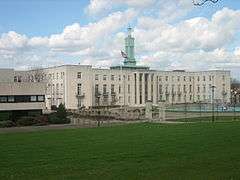 Walthamstow Town Hall on Forest Road, built for the Borough of Walthamstow in 1941 |
|
 Walthamstow |
|
| Population | 109,424 2011 Ward Populations |
|---|---|
| OS grid reference | TQ372891 |
| – Charing Cross | 7.5 mi (12.1 km) SW |
| London borough | Waltham Forest |
| Ceremonial county | Greater London |
| Region | London |
| Country | England |
| Sovereign state | United Kingdom |
| Post town | LONDON |
| Postcode district | E17 |
| Dialling code | 020 |
| Police | Metropolitan |
| Fire | London |
| Ambulance | London |
| EU Parliament | London |
| UK Parliament | Walthamstow |
| London Assembly | North East |
Coordinates: 51°35′02″N 0°01′16″W / 51.584°N 0.0211°W
Walthamstow (/ˈwɔːlθəmstoʊ/ or /ˈwɒlθəmstoʊ/) is the principal town of the London Borough of Waltham Forest in East London,[1] England. It is located 7.5 miles (12.1 km) northeast from Charing Cross.[2]
Historically in the county of Essex, it significantly increased in population as part of the suburban growth of London and was incorporated as a municipal borough in 1929 before becoming part of Greater London in 1965.
Walthamstow is a large town, situated between the North Circular Road to the north, Lee Valley and the Walthamstow Reservoirs to the west, and Epping Forest to the east. The town centre consists of Walthamstow Market, the longest single street market in Europe.
History
Toponymy
Walthamstow is recorded c. 1075 as Wilcumestowe ("the Place of Welcome") and in the Domesday Book of 1086 as Wilcumestou.[3]
Early history
| 1871 | 10,692 |
|---|---|
| 1881 | 21,715 |
| 1891 | 46,346 |
| 1901 | 95,131 |
| 1911 | 124,580 |
| 1921 | 129,395 |
| 1931 | 132,972 |
| 1941 | war # |
| 1951 | 121,135 |
| 1961 | 108,845 |
| # no census was held due to war | |
| source: UK census[4] | |
King John visited Shern Hall (Shernhall Street) in 1213; the building survived until 1896. At one point Walthamstow was just a culmination of five small villages, and affairs were discussed at Vestry House, acting as the first town hall. In 1870 it had grown to the size of a small suburb and a town hall was built in Orford Road from which affairs of the village were run (which now takes place in Forest Road - since 1941). Until the 19th century it was largely rural, with a small village centre (now Walthamstow Village — see below) and a number of large estates.
The main route through the district was the aforementioned Hoe Street. Additionally, there were various smaller lanes, crossing the town. The road now known as Forest Road was originally called Clay Street.[5] Further south, the High Street was named Marsh Street, and led from the original settlement out to the marshes. Shernhall Street is an ancient route, as is Wood Street, to the east. In the 1660s Sir William Batten, Surveyor of the Navy, and his wife Elizabeth Woodcocke had a house here where, according to Samuel Pepys, they lived "like princes" and cultivated a vineyard.

Urban development
With the advent of the railways and the ensuing suburbanisation in the late 19th century, Walthamstow experienced a large growth in population and speculative building.[6]
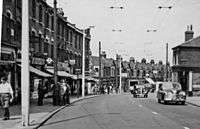
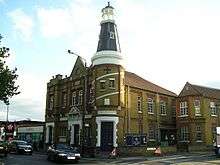

The Lighthouse Methodist Church which dates from 1893 which is situated on Markhouse Road, on the corner of Downsfield Road. There is a lantern at the top of the tower, which also contains a spiral staircase. The church was erected because of the generosity of Captain David King of the shipbuilding firm of Bullard King & Co which also ran the Natal Direct Shipping Line, which ran ships direct from London to Durban without stopping at the Cape.
The LGOC X-type and B-type buses were built at Blackhorse Lane from October 1908 onwards. The B-type is considered one of the first mass-production buses. The manufacturing operation later became AEC, famous as the manufacturer of many of London's buses. On 13 June 1909, A. V. Roe's aircraft took to the air from Walthamstow Marshes. It was the first all-British aircraft and was given the ominous nickname of the "Yellow Terror" but officially carried the name Avro1. Roe later founded the Avro aircraft company, which later built the acclaimed Avro Lancaster.
Local government
From 1894 Walthamstow was an urban district and from 1929 a municipal borough in Essex. In 1931 the population of the borough, covering an area of 4,342 acres (17.57 km2), peaked at 132,972.[7] In 1965 the borough was abolished and its former area merged with that of the Municipal Borough of Chingford and the Municipal Borough of Leyton to form the London Borough of Waltham Forest in Greater London.[7] Other places in east London formerly of the county of Essex, such as Ilford and Romford were placed into London Boroughs along with Walthamstow. None of the postal district names or codes was changed at this time (e.g. Ilford remained Ilford, Essex, and Walthamstow remained London E17).
Recent history
Since the 2012 Summer Olympics, the town has become increasingly popular mostly as a result of gentrification. Local property prices have increased at a high rate of 22.3% from 2013-2014, compared to London's average of 17.8%.[8] It has turned Walthamstow into a 'trendy' town similar to Shoreditch, and has earned the nickname Awesomestow as a result.[9] The leafy Walthamstow Village in particular has become sought-after by buyers.[10]
On 29 May 2015, a regular local unicyclist was hit and dragged under by a double decker route 212 bus in Hoe Street. Locals numbering up to 100 people helped to pull the bus off the unicyclist.[11][12] The MP for Walthamstow, Stella Creasy, later said she was "proud" of the community for saving the unicyclist's life.[13]
Governance
Walthamstow elects councillors to Waltham Forest London Borough Council.
Geography
Walthamstow is bordered to the north by Chingford, south by Leyton and Leytonstone, east by the southern reaches of Epping Forest at Woodford and west by Tottenham and the River Lea valley. Leyton High Road, Hoe Street, Chingford Road, Chingford Mount (passing south-north through Walthamstow and its neighbouring towns) form part of an ancient route from London to Waltham Abbey.
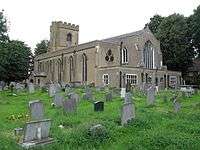
Walthamstow Central is the main town centre and includes Selborne Road and the High Street.
Walthamstow Village conservation area is a peaceful and attractive district to the east of what has become the commercial centre of Walthamstow. The area is roughly defined as being south of Church Hill, west of Shernhall Street, north of Grove Road and east of Hoe Street. Orford Road is the main route through the district, though even this is a quiet thoroughfare by the standards of London. The village has a small selection of specialist shops, pubs and restaurants, and house prices tend to be higher in the streets of this neighbourhood. It was voted best urban village in London by Time Out magazine in 2004.
Upper Walthamstow is to the east of Walthamstow Village. The area's main thoroughfare is Wood Street, which has a good selection of shops and local businesses, and is served by railway, with a railway station on the Liverpool Street to Chingford line.
Wood Street is home to Wood Street Indoor Market.[14] The market was the site of a cinema from 1912 to 1955, operated by the Penny Picture Theatre Co. It re-opened under new independent management in 1953 as the Rio Cinema, but this was short lived and it closed in 1955.[15] Now the market is filled with quirky market traders, and was documented in a short documentary made by Mark Windows.[16]
Walthamstow has a wide variety of housing stock, but the vast majority of residential property was built in the early 20th century. From Coppermill Lane in the west (next to the marshes), to Wood Street in the east, there are scores of terraced streets dating to the Edwardian era and the 1920s. The area along Markhouse Road and St James Street has many examples of Warner properties. These were developed as affordable housing for the working classes in the early part of the 20th century. Bombing raids in the Second World War and urban redevelopment projects in the 1960s and 1970s have left areas with more modern housing, mostly in the shape of low-rise concrete blocks.
The northern continuation of Markhouse Road is St James's Street to which Blackhorse Road follows, served by underground and railway stations, which in turn becomes Blackhorse Lane. This is bound on its western side by industrial units and warehouses. The London Borough of Waltham Forest has proposed developing the area around Blackhorse Road railway station to become a gateway to the town.
Highams Park and Hale End, though both in the E4 postcode, are historically part of Walthamstow.
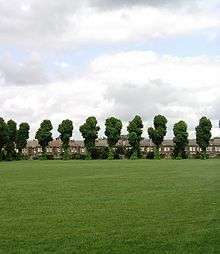
Although bounded by the marshes to the west and parts of Epping Forest to the east, there is little open space in the actual town. There used to be two commons in the town, Church Common, adjacent to St. Mary's Church in Walthamstow Village and Markhouse Common, located off Markhouse Lane (now Markhouse Road) and what is now the western end of Queens Road. Both open spaces were lost in the 19th century, when the land was sold to property developers. Lloyd Park has been open to the public since 1900 and is located in Forest Road behind the William Morris Gallery. It has a formal garden with a pond, and the adjacent Aveling Field has facilities for bowling, tennis, basketball, an outdoor gym, a skate park and a children's play area.[17]
Demography
Walthamstow's large size and seven wards makes it difficult to obtain demographics about the town as a whole. The wards that cover Walthamstow are: Chapel End (northeastern part), Higham Hill (northwestern part), High Street (western), Hoe Street (inner-eastern and Walthamstow Village), Markhouse (southwestern), William Morris (northern), and Wood Street (eastern and Upper Walthamstow).
As of the 2011 census, White British is the largest ethnic in all wards. Other White is the second largest in all wards except Markhouse. The other double-digit ethnics are Pakistani and Black African. The highest White British ward is Chapel End (35%),[18] whereas the lowest is Markhouse (24%).[19] Other White is largest in High Street (18%) and lowest in Wood Street (14%). Pakistani is highest in Markhouse (18%) and lowest in both Chapel End and Higham Hill (9%).[20] Black African is largest in Higham Hill (10%).[20]
Economy

The High Street is dominated by Walthamstow Market, which began in 1885, and occupies all but the last 100 yards of the street. It is reputed to be a mile long, but in fact measures approximately ⅔ of a mile. It is the longest street market in Europe. The market is open five days a week (not Sunday or Monday), and there is a Sunday farmers' market. The street is lined with shops: a selection of high street chains, but also many independent small shops specialising in food, fabrics, and household goods, as well as cafés. The overall tone is downmarket and unique. There are two patches of new-ish development: at Sainsbury's, and the Mall Selborne Walk covered shopping centre[21] both of which have large multi-storey car parks. Shopmobility Waltham Forest operates in the Mall, loaning mobility scooters and wheelchairs, with volunteer helpers, to disabled and older people.
The historic central library on the High Street was one of many built with money donated by the Scottish-American businessman and philanthropist Andrew Carnegie, whose portrait bust can be seen on the exterior of the building. It was modernised and expanded in 2006–07, although there were claims that this was at the expense of book holdings. According to the Waltham Forest Guardian, "almost a quarter of a million books have gone missing from Waltham Forest libraries amid claims they have been burned or pulped", and the borough's library stock fell by 60% over the two previous years.[22] At the same time, a large plot at the corner of High Street and Hoe Street was set for substantial redevelopment as a retail space. This site was previously the location of the town's central post office and a shopping arcade built in the 1960s. Plans for the redevelopment of this site initially fell through in 2005, but work on a new cinema, flats and restaurants started in April 2013 and was completed in December 2014.[23]
Transport

Train stations include:
- Walthamstow Central (London Underground Victoria Line, London Overground)
- Blackhorse Road (London Underground Victoria Line, London Overground)
- Walthamstow Queen's Road (London Overground)
- Wood Street (London Overground)
- St James Street (London Overground)
- Lea Bridge (Abellio Greater Anglia)
Lea Bridge is in the far southwestern edge of Walthamstow, near Upper Clapton. The station was opened in 2016. All other stations in the area are operated by Transport for London (TfL) services.
Walthamstow lost its rail link to Stratford with the removal of the 550 yards length of track known as the Hall Farm Curve in 1970, and there have been campaigns for its re-instatement.
London Buses routes 20, 34, 48, 58, 69, 97, 212, 215, 230, 257, 275, 357, 675, W12, W15, W19 and night route N26 serve the area. In addition, route 69 provides a 24-hour service.[24] Bus services include a full infrastructure including a Hopper service and a multi point to point network exists; serviced from and to its own main bus station terminus situated near the train station, along with a cross network passing through the centre and outskirts.
Culture
In popular music
Walthamstow was home to the popular 1990s boy band East 17, who named themselves after the area's postal code E17, and titled their debut album Walthamstow. The indie rock band The Rifles are from the area as was Jimmy Ray. Ray grew up in the Lloyd Park area and attended Winns primary, and Sidney Chaplin and McEntee secondary schools. In the early 1990s he performed at various E17 venues, including the Royal Standard, as part of local pop group 'The Cutting Room'. Ray later had solo hits in the UK and US. It is home to the band The Bevis Frond.
Walthamstow is a major centre in London's grime music scene, with many bedroom studios and underground music enterprises. Artists include Lethal Bizzle and his band Fire Camp.
The Bromheads Jacket song "Poppy Bird" references Walthamstow in the chorus.
Walthamstow is mentioned in the Paul McCartney and Wings song "Old Siam, Sir" from the 1979 album Back to the Egg.
"Long ago, outside a chip shop in Walthamstow" is the first line of a song named "Ann and Joe", recorded by The Barron Knights in the late 1970s. This was a spoof of "Long ago, high on a mountain in Mexico", the opening words of Angelo, which was a UK number one hit in 1977 for Brotherhood of Man.
"Waiting in Walthamstow" is a song by The Cranberries from the album Roses.
The track the "Battle of Epping Forest" by Genesis on the album Selling England by the Pound has lyrics based in the area such as "Along the Forest Road, there's hundreds of cars - luxury cars."
The artwork for Blur's Parklife album featured photos of the band at Walthamstow Stadium.
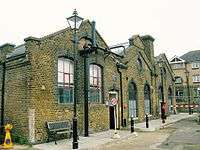
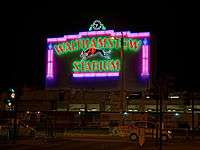
Cinema
The Walthamstow Studios operated between 1914 and 1930. EMD (Granada) Walthamstow on Hoe Street closed in 2003 and remains unused.[25] The Empire cinema[26] opened in December 2014.
Sports clubs
- Waltham Forest F.C.
- Walthamstow Avenue F.C. (defunct club located at Green Pond Road Stadium)
- Walthamstow Avenue & Pennant
- Haringey & Waltham Development F.C.
- Walthamstow Cricket Club[27]
Education
Walthamstow secondary schools include:
- Frederick Bremer School
- Forest School
- Holy Family Catholic School
- Kelmscott School
- Walthamstow Academy
- Walthamstow School for Girls
- Willowfield School
Sixth form and further education providers include:
Notable residents

One of its most famous residents was the writer, poet, designer and socialist William Morris, who was born there on 24 March 1834, and lived there for several years. His former house in Walthamstow is a museum dedicated to his life and works, while the grounds of the house are a public park (Lloyd Park in Forest Road).
Local engineer, Frederick Bremer, built the first motor car in London between 1892 and 1894. In 1912 The Motor magazine, after much debate, recognised the Bremer car as the first British built petrol-driven car (now on display in the Vestry House Museum).
- Keith Albarn, manager of Soft Machine and father of Damon Albarn, taught art at Walthamstow Art College in the 1960s
- Clement Attlee, Member of Parliament for Walthamstow while he was Prime Minister.
- Sir William Batten (died 1667), Surveyor of the Navy, had a "palatial" country house at Walthamstow; his son, who was in debt, sold it off a few years after his death.
- Stephen Bear reality TV star
- Alonza Bevan, bass guitarist of Kula Shaker.
- Lethal Bizzle, Rap/Grime artist[28] and associated rap collective Fire Camp, Attended Holy Family Catholic School.
- Denis Blackham, renowned music mastering engineer.
- Peter Blake, artist, painted sleeve cover of the Beatles Sgt. Peppers Lonely Hearts Club Band.
- Mick Box, guitarist for Uriah Heep born in Walthamstow.
- Matthew Bourne OBE, choreographer and dancer, was born in Walthamstow.
- Theodore Ronald Brailey pianist on the RMS Titanic
- Frederick Bremer, inventor, built the first petrol driven car in Great Britain in 1892
- David Cairns guitarist with Secret Affair was born in Walthamstow in 1958.
- Alexander Champion Founder of British whaling - died 1795 in Walthamstow.
- Anjem Choudary, Radical Islamist hate preacher
- Phil Collen, lead guitarist of Def Leppard.
- Stella Creasy, Labour MP
- Johnny Dankworth, jazz musician, who attended Sir George Monoux Grammar School.
- Paul Di'Anno, lead singer of Iron Maiden 1978–81.
- Adam Devlin, guitarist for the Bluetones lives in Walthamstow.
- Benjamin Disraeli, former British Prime Minister, attended Higham Hall School in Walthamstow, as did William Shore, later father of Florence Nightingale
- Ian Dury, singer and songwriter, studied at Walthamstow Art College.
- Fleur East, singer and The X Factor Finalist (Runners-up), Attended Holy Family Catholic school
- East 17, British pop boy band, including singer/songwriter Brian Harvey.
- Sir George Edwards, designer of Concorde
- Lucian Ercolani Founder of furniture company Ercol, was living at 27 Claremont Road, Walthamstow in the 1911 census
- Air Marshal Sir Kenneth Charles Michael Giddings CB OBE DFC AFC and Bar, born in Walthamstow in 1920
- Maurice Glasman, social theorist and Labour life peer
- Peter Greenaway, film director,studied at Walthamstow College of Art
- Fitz Hall, English footballer currently playing for Watford was born in Walthamstow
- Darren Hayman, singer and songwriter
- Helen Hollick, writer, born in Walthamstow 1953
- James Hilton, author, attended George Monoux Grammar School
- Lord Peter Hennessy of Nympsfield, former journalist with The Times; historian, academic and author
- Mick Hume, journalist
- Countess Judith, wife of Earl Waltheof, prominent post-Conquest woman
- Harry Kane, footballer, attended Chingford Foundation School
- Colin Kazim-Richards, footballer, was born in Leytonstone but schooled in Walthamstow
- Agnes Marshall, English culinary entrepreneur, born in Walthamstow in 1855
- Sir George Monoux, Lord Mayor of London in 1514 and local benefactor; founded the grammar school and almshouses
- William Morris, designer, socialist and artist
- Fabrice Muamba, footballer, attended Kelmscott School
- Denis Payton, saxophonist for the Dave Clark Five, was born in Walthamstow 1943
- Grayson Perry, ceramicist and 2003 Turner Prize winner, had his studio in Walthamstow until 2014. He referred to Walthamstow in his 2013 Reith lectures, naming it 'Awesomestow'
- Pascale Petit, poet, nominated twice for the TS Eliot poetry prize
- DJ Rap (Charissa Saverio) grew up in Walthamstow and lived there until recently, was born in Singapore
- Jimmy Ray, recording artist, born Walthamstow 1970
- Ken Russell, film director, studied at Walthamstow Technical College
- Nick Saloman, progressive rock musician
- June Sarpong, television presenter, born Walthamstow 1977
- Baroness Scotland, Attorney General, grew up in Walthamstow and attended Walthamstow School for Girls
- Vivian Stanshall, musician, painter, singer, broadcaster, songwriter, poet and writer, best known for his work with the Bonzo Dog Doo-Dah Band, grew up in Grove Road, Walthamstow.
- John Kemp Starley, inventor, born Walthamstow 1854
- Colin Stinton, Canadian-born actor
- Thomas Griffith Taylor (1890–1963) Antarctic explorer
- Lawrence Trent, international chess master and commentator
- Peter Waterfield Olympic diver
- Dorothy Wedderburn Principal of Bedford College and Royal Holloway and Bedford New College, both London University, was born in Walthamstow 1925
- Danniella Westbrook, Actress
- Geoffrey Wellum, RAF fighter pilot in the Battle of Britain was born Walthamstow in 1921
- Timothy Williams, bilingual novelist of crime fiction, lived at Whipps Cross
- Peter Winch, philosopher
- Adam Woodyatt, English actor who plays Ian Beale in EastEnders, born in Walthamstow 1968
- Lutalo Muhammad, British taekwondo athlete, attended Holy Family Catholic School
Gallery
 St Mary's Parish Church dates from the 12th century
St Mary's Parish Church dates from the 12th century Walthamstow Old Town Hall
Walthamstow Old Town Hall 15th century "Ancient House" in Walthamstow village
15th century "Ancient House" in Walthamstow village Monoux Almshouses in the village
Monoux Almshouses in the village Vestry House Museum
Vestry House Museum William Morris Gallery
William Morris Gallery Longitude Zero marker in Upper Walthamstow Road
Longitude Zero marker in Upper Walthamstow Road Walthamstow Central Library
Walthamstow Central Library Selborne Walk Shopping Centre
Selborne Walk Shopping Centre St. Peter's-in-the-Forest church, near Woodford New Road in the southern edge of Epping Forest
St. Peter's-in-the-Forest church, near Woodford New Road in the southern edge of Epping Forest- Walthamstow Reservoir
- Walthamstow Marshes
 Front of the bus and train station interchange
Front of the bus and train station interchange View of the A406 North Circular Road from a footbridge in eastern Walthamstow, near Woodford
View of the A406 North Circular Road from a footbridge in eastern Walthamstow, near Woodford The filter beds at Coppermills Treatment Works
The filter beds at Coppermills Treatment Works The old Town Hall
The old Town Hall
References
- ↑ "London's Places" (PDF). Greater London Authority. GLA. Retrieved 16 October 2015.
- ↑ Mayor of London (February 2008). "London Plan (Consolidated with Alterations since 2004)" (PDF). Greater London Authority.
- ↑ Mills, A., Oxford Dictionary of London Place Names, Oxford University Press, ISBN 978-0-19-956678-5, (2001)
- ↑ "Walthamstow CP/AP through time | Population Statistics | Total Population". Visionofbritain.org.uk. Retrieved 2015-08-01.
- ↑ "Walthamstow -- Introduction and domestic buildings". University of London & History of Parliament Trust. Retrieved 2013-06-30.
- ↑ Walthamstow: Introduction and domestic buildings, A History of the County of Essex: Volume 6 (1973), pp. 240–50. Date accessed: 1 April 2007.
- 1 2 "History of Walthamstow, Essex". University of Portsmouth. Retrieved 2013-06-21.
- ↑ https://next.ft.com/content/230e6062-a70b-11e4-8a71-00144feab7de
- ↑ https://www.london.gov.uk/city-hall-blog/why-walthamstow-called-awesomestow
- ↑ https://www.theguardian.com/business/2015/dec/17/gentrification-fears-east-london-property-millionaires
- ↑ https://www.theguardian.com/uk-news/2015/may/29/unicyclist-in-hospital-after-collision-with-bus-in-london
- ↑ http://www.bbc.co.uk/news/magazine-32993891
- ↑ http://www.standard.co.uk/lifestyle/london-life/stella-creasy-i-m-proud-of-how-my-community-lifted-a-bus-to-save-that-cyclist-10304905.html
- ↑ "Wood Street Indoor Market | Wood Street Indoor Market, Walthamstow, E17 Website". Woodstreetmarket.com. Retrieved 2015-08-01.
- ↑ "Crown Cinema". Retrieved 2013-06-30.
- ↑ "the collectors of wood street". YouTube. 2006-07-19. Retrieved 2015-08-01.
- ↑ "Lloyd Park". Walthamforest.gov.uk. London Borough of Waltham Forest. Retrieved 6 February 2015.
- ↑ http://www.ukcensusdata.com/chapel-end-e05000592
- ↑ http://www.ukcensusdata.com/markhouse-e05000606
- 1 2 http://www.ukcensusdata.com/higham-hill-e05000600
- ↑ "Shopping Centres in the UK - The Mall Shopping Centres". Themall.co.uk. Retrieved 2015-08-01.
- ↑ WALTHAM FOREST: Were 250,000 library books burned?, Sarah Cosgrove, Waltham Forest Guardian, 22 November 2007
- ↑ "Walthamstow arcade site". London Borough of Waltham Forest. Retrieved 2013-06-30.
- ↑ https://tfl.gov.uk/bus/stop/HUBWHC/walthamstow-central. Missing or empty
|title=(help) - ↑ "Granada Cinema, Walthamstow, in 1989". Retrieved 2013-06-21.
- ↑ "EMPIRE CINEMAS Listings for Walthamstow". Empirecinemas.co.uk. Retrieved 2015-08-01.
- ↑ "Walthamstow Cricket Club : home". Walthamstowcc.hitscricket.com. 2015-06-03. Retrieved 2015-08-01.
- ↑ "Comment: editorials, opinion and columns". Telegraph. Retrieved 2015-08-01.
External links
- Waltham Forest London Borough Council - Regeneration of Walthamstow town centre
- British History Online - A History of the County of Essex: Volume 6
- Richard Dunn - A brief history of Walthamstow
- Walthamstow Memories - Recollections of past and present Walthamstow residents.
- Archival Material relating to Walthamstow listed at the UK National Register of Archives
| Wikimedia Commons has media related to Walthamstow. |
- Portraits of Valentine La Touche McEntee, 1st Baron McEntee of Walthamstow at the National Portrait Gallery, London
- Images of Walthamstow at the English Heritage Archive
- Nostalgic photos of Walthamstow at History-in-Pictures.co.uk
